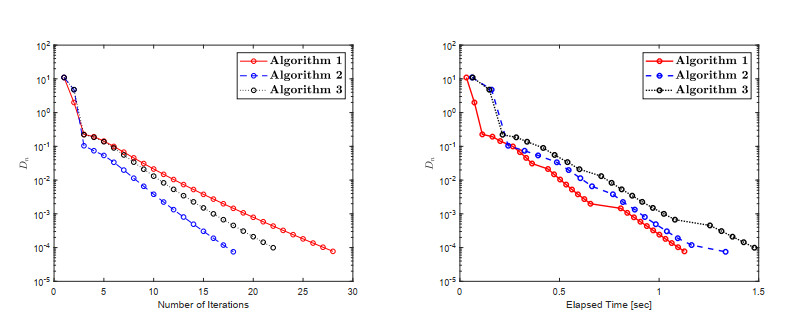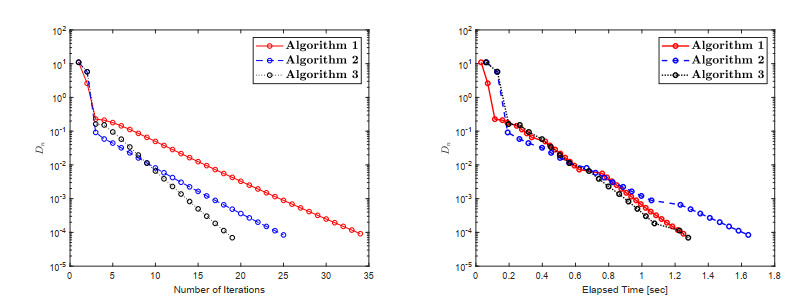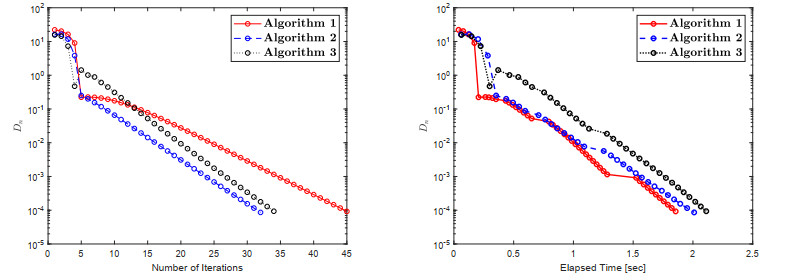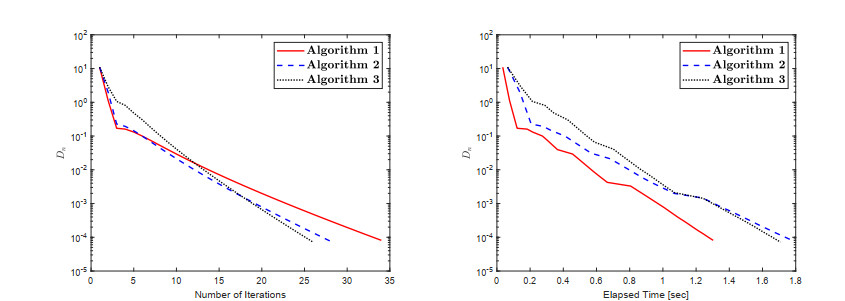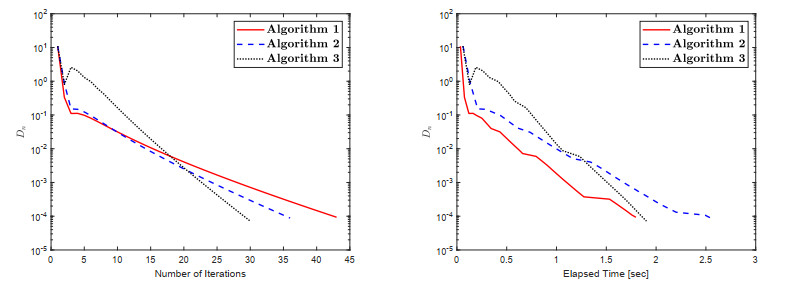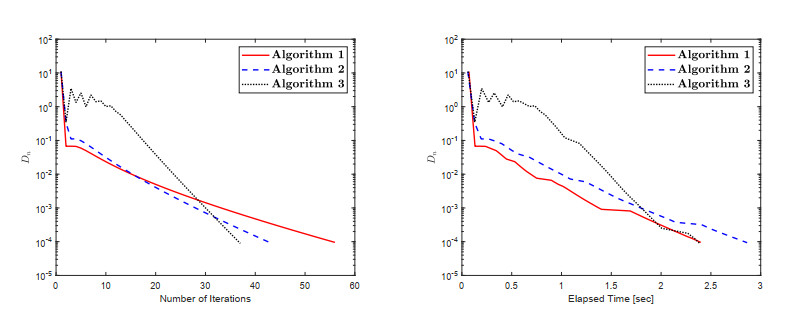1.
Introduction
The primary objective of this study is to look into the iterative methods used to solve the variational inequality problem [13] including quasi-monotone operators in any real Hilbert space. Consider that A:H→H is a mapping. Assume H is an arbitrary Hilbert space and K is a nonempty, closed, and convex subset of H. The variational inequality problem for mapping A on K is defined as follows:
Conditions of convergence study. The following conditions must be met in order to investigate the strong convergence of proposed algorithms.
(A1) The solution set of a problem (1.1) is denoted by VI(K,A) and nonempty it is non-empty;
(A2) A:H→H is said to be quasi-monotone if
(A3) A:H→H is said to be Lipschitz continuous with L>0 such that
(A4) A:H→H is sequentially weakly continuous if {A(ri)} weakly converges to A(r) for each {ri} weakly converges to r.
The formal formulation of the variational inequality problem is an important topic in nonlinear analysis. It is a key mathematical model that advances many important ideas in modern mathematics, such as optimization conditions for problems with the optimization process, nonlinear systems of equations, complementarity problems, finance, and network equilibrium problems (see for more details [12,17,18,19,20,27,30]). As a result, this concept has a wide range of applications in mathematics, engineering, transportation studies, network economics, game theory, and computer science. The regularized approach and the projection algorithm are both useful and general solutions for dealing with variational inequalities. It should also be noted that the first algorithm is most commonly used to deal with variational inequalities that are largely determined by the monotone operator class. The regularized subproblem is strongly monotone in this approach, and its unique solution is determined to be more convenient than the primary problem. In this study, we will look into projection methods that are well-known for their simplicity of numerical calculation. Many researchers have examined not just the theory of solution existence and stability but also iterative procedures for dealing with variational inequality problems (see for more details [2,7,15,44,45,46]) and others in [24,29,32,33,34,35,36,38].
Furthermore, projection methods are appropriate for finding a numerical solution to variational inequalities. Many researchers have created novel projection techniques to deal with various types of variational inequalities [3,5,8,9,10,16,21,26,28,37,47,48,49] and others in [4,6,39,40,41,42,43]. All algorithms for resolving the (1.1) problem are based on computing a projection on the appropriate set K. The corresponding extragradient method was developed by Korpelevich [21] and Antipin [1]. Their algorithm is designed as follows:
where 0<ϰ<1L. In accordance with the previous algorithm, we used two projections on the underlying set K for each iteration. If the feasible set K has a complicated structure, the method's computing capabilities may be decreased. This section will go over various methods for getting around this limitation. The first is Censor et al. [8] subgradient extragradient algorithm. This algorithm is defined as follows:
where 0<ϰ<1L with
In this study, we will focus on Tseng's extragradient algorithm [37], which uses only one projection each iteration. This algorithm is defined as follows:
while 0<ϰ<1L. It is worth noting that the previous two algorithms have two major flaws: a fixed stepsize rule that is dependent on the Lipschitz constant of the cost operator and generates a weakly convergent iterative sequence. The Lipschitz constant of a mapping is often unknown or difficult to approximate. A fixed stepsize criterion that influences the method's efficacy and speed of convergence. Furthermore, in the case of an infinite-dimensional Hilbert space, the investigation of a strongly convergent iterative sequence is important.
The purpose of this research is to solve variational inequalities in an infinite-dimensional Hilbert space using a quasi-monotone operator. Furthermore, the proposed algorithms take into account the extension and modification of the previous results [11,31]. We show that Tseng's iterative sequence for solving variational inequalities with quasi-monotone operators is strongly convergent to a solution. Tseng's inertial-type extragradient approach makes use of both monotone and non-monotone variable stepsize rules. For each algorithm, we created a series of computational studies.
The following is the format of the paper: Preliminary results are provided in Section 2. All new algorithms and their convergence analysis are described in Section 3. Finally, Section 4 presents some numerical results to show the practical usefulness of the proposed algorithms.
2.
Preliminaries
This section contains various important identities as well as significant lemmas. For any ϝ1,ϝ2∈H, we have
Furthermore, a set is defined as follows:
A metric projection PK(e1) of e1∈H is defined by
Lemma 2.1. [23] Let {ai}⊂[0,+∞) be a sequence satisfying the following inequality
where {αi}⊂(0,1) and {βi}⊂R are two sequences such that
Then, limi→+∞ai=0.
Lemma 2.2. [25] Let {ai}⊂R be a sequence with {ij} is a subsequence of {i} such that
Then, there exists a nondecreasing sequence mk⊂N with
such that
Eventually, mk=max{j≤k:aj≤aj+1}.
3.
Main results
In this section, we present three new inertial methods for solving quasi-monotone variational inequalities in a real Hilbert space. We verified that the sequences generated by the proposed algorithms are strongly convergent. The following three methods are modified variants of Tseng's extragradient method [37]. The nature of their use of the stepsize rule differentiates these three algorithms between each other. The primary objective of this study is to extend and modify Tseng's extragradient method [37] and compare the numerical efficiency of the algorithms in terms of their stepsize rule.
Lemma 3.1. Let {ϰi} sequence is created due to (3.7) is diminishing and converges monotonically to ϰ>0.
Proof. The proof is similar to the proof of Lemma 3.1 in [22].
Lemma 3.1. Let {ϰi} is a sequence is created due to (3.14) is convergent to ϰ with
Proof. The proof is similar to the proof of Lemma 3.1 in [22].
Lemma 3.2. Suppose A:H→H satisfies the conditions (A1)–(A4) and sequence {ui} generated due to Algorithm 1. For any u∗∈VI(K,A)+, we have
Proof. It is given that u∗∈VI(K,A), such that
It provides that vi=PK[wi−ϰA(wi)] and it implies that
Thus, we have
Combining expressions (3.1) and (3.3), we obtain
It is given that u∗ is the solution of the problem (1.1) implies that
It implies that
By substituting v=vi∈K, we have
From expressions (3.4) and (3.5), we obtain
Lemma 3.4. Consider that A:H→H satisfies the conditions (A1)–(A4). Let {ui} generated due to Algorithm 2. For any u∗∈VI(K,A)+, we have
Proof. Let u∗∈VI(K,A) and by description of ui+1, we obtain
It is given that vi=PK[wi−ϰiA(wi)] and indicates that
or, in certain cases, equivalently u∗∈VI(K,A), we are able to write
From (3.8) and (3.10), we have
Thus, we obtain
Because the property of A on K, such as
Substituting v=vi∈K, we have
Combining expressions (3.11) and (3.12), we obtain
Lemma 3.5. Consider that A:H→H satisfies the conditions (A1)–(A4). Let {ui} generated due to Algorithm 3. For each u∗∈VI(K,A), we have
Proof. The proof is similar to the proof of Lemma 3.4.
Theorem 3.1. Let a mapping A:H→H satisfies the conditions (A1)–(A4). Then, the sequence {ui} generated due to Algorithm 3 converges strongly to u∗=PVI(K,A)(0).
Proof. Due to the value of {wi} such that
where
Since ϰi→ϰ to use a certain number ℑ∈(0,1−χ2) such that
As a result, a finite number N1∈N appears here such that
By the use of Lemma 3.4, we obtain
Due to Eqs (3.16) and (3.18), we have
As a result, we may conclude that {ui} is a bounded sequence.
Apparently, relation (3.16) gives that
for some K2>0. Combining expressions (3.13) and (3.20) we have
From expression (3.15), we can write
Due to Eqs (3.18) and (3.22), we obtain
Case 1. Consider there is a definite integer N2∈N (N2≥N1) such that
The relation implies that limi→+∞‖ui−u∗‖ exists and let limi→+∞‖ui−u∗‖=l, for l≥0. Hence, we have
Because of the existence of the limits ‖ui−u∗‖ and ϑi→0, we may derive that
It follows that
The preceding statement suggests that
It continues from expression (3.26) that
Following that, we evaluate
The accompanying statement indicates that
Since {wik} weakly convergent to ˆu and thus limk→+∞‖wik−vik‖=0, then {vik} also convergent weakly to ˆu. Then, we must demonstrate that is ˆu∈VI(K,A). From the value of vi, we get
that is equivalent to
The above inequality implies that
Thus, we obtain
By the use of limk→+∞‖wik−vik‖=0 and k→+∞ in (3.33), we have
Furthermore, it implies that
Since limk→+∞‖wik−vik‖=0. Thus, we have
which together with (3.35) and (3.36), we obtain
Furthermore, consider a positive sequence {ϵk} that would be decreasing and converging to zero. There is indeed a least positive integer represented by mk for each {ϵk} such that
Because {ϵk} is a diminishing sequence, it is straightforward to observe that {mk} is increasing.
Thus, we have
Due to the above definition, we have
Moreover, from expressions (3.38) and (3.40) for all imk≥N0, we have
By the definition of quasi-monotone, we have
Due to all integer imk≥N0, gives that
Furthermore, we might draw the conclusion that
It is given that {wimk}⊂{wik} with limk→+∞ϵk=0. It follows from this that
By letting k→+∞ in expression (3.43), we get
Consider the case when u∈K is an arbitrary element and 0<ϰ≤1. Thus, we have
Then ˆuϰ∈K and from expression (3.46), we have
Hence, we have
Let ϰ→0. Then ˆuϰ→ˆu along a line segment. By the continuity of an operator, A(ˆuϰ) converges to A(ˆu) as ϰ→0. It follows from expression (3.49) such that
Hence ˆu∈VI(K,A). It is given that u∗=PVI(K,A)(0), we have
As a result, we obtain
By using the fact that limi→+∞‖ui+1−ui‖=0. As a result of employing the formula (3.52), we receive
We may derive from the Eqs (3.23) and (3.53), and Lemma 1 that ‖ui−u∗‖→0 as i→+∞.
Case 2. suppose the fact that somehow there arises a subsequence {ij} of {i} in order that
A sequence exists {mk}⊂N as {mk}→+∞ by applying Lemma 2, such that
As in Case 1, the Eq (3.25) suggests that
Due to ϑmk→0, and following step as in Case 1
Furthermore, it follows that
Following that, we must evaluate
The preceding statement suggests that
By adopting the same argument as in Case 1, in order that
Using merging the formulae (3.23) and (3.54). Thus
Consequently, we acquire
Since ϑmk→0 and ‖umk−u∗‖ is a bounded sequence. Thus, Eqs (3.60) and (3.62), we get
The accompanying phrase suggests
As a result, the sequence ui→u∗ is represented as i→+∞.
Remark 3.1. The convergence studies for the Algorithms 1 and 2 are analogous to the proof of Theorem 3.1.
3.1. Methods to solve semistrictly quasi-monotone variational inequalities
In this part, we present two new inertial methods for solving quasi-monotone variational inequalities in a real Hilbert space. Let H be a real Hilbert space. Given u,v∈H and closed line segment is defined as follows:
The segments (u,v], [u,v), and (u,v) are defined similarly. A mapping A:H→H is said to be semistrictly quasi-monotone [14] on K if A is quasi-monotone on K and for all distinct of points u,v∈K, we have that
The first method (Algorithm 4) is a modified variant of the two-step extragradient method [21] with a non-monotone stepsize rule to solve variational inequalities involving semistrictly quasi-monotone operators.
The second method (Algorithm 5) is a modified variant of the Tseng's extragradient method [37] with a non-monotone stepsize rule to solve variational inequalities involving semistrictly quasi-monotone operators.
4.
Numerical illustration
This section evaluates the numerical performance of the proposed algorithms to some relevant work in the literature, as well as how changes in control parameters affect the numerical validity of the proposed algorithms.
All computations are done in MATLAB R2018b and run on HP i-5 Core(TM)i3-6200 6.00 GB (5.78 GB usable) RAM laptop.
Example 4.1. Assume that a real Hilbert space H=l2 square summable sequences
Let A:K→K be an operator is defined by
where K={u∈H:‖u‖≤3}. It is simple to demonstrate that A is sequentially weakly continuous on H with VI(K,A)={0}. Take any two elements u,v∈H, such that
The mappings L is Lipschitz continuous through a parameter value of L=11. Take any two elements u,v∈H, and consider ⟨A(u),v−u⟩>0, with
Because ‖u‖≤3, as a result of
Take this into consideration:
It demonstrates that A is quasi-monotone on the set K. The projection formula is defined by:
The numerical findings are shown in Table 1 and Figures 1–3. While defining the control conditions, the following factors are taken into account:
(1) Algorithm 1:
ϰ=0.5L,θ=0.50,ϵi=1(i+1)2,u1=(1,1,⋯,150000,0,0,⋯),Di=‖wi−vi‖; (2) Algorithm 2:
ϰ1=0.55,χ=0.33,θ=0.50,u1=(1,1,⋯,150000,0,0,⋯),ϵi=1(i+1)2,Di=‖wi−vi‖; (3) Algorithm 3:
ϰ1=0.55,χ=0.33,θ=0.50, φi=100(i+1)2,u1=(1,1,⋯,150000,0,0,⋯),ϵi=1(i+1)2,Di=‖wi−vi‖.
The numerical findings are shown in Table 2 and Figures 4–6. The control conditions are considered in the following way: (1) Algorithm 1: ϰ=0.7L,θ=0.66,ϵi=1(i+1)2,ϑi=1(i+2),Di=‖wi−vi‖; (2) Algorithm 2: ϰ1=0.45,χ=0.44,θ=0.66,ϑi=1(i+2),ϵi=1(i+1)2,Di=‖wi−vi‖; (3) Algorithm 3: ϰ1=0.45,χ=0.44,θ=0.66,φi=100(i+1)2,ϑi=1(i+2),ϵi=1(i+1)2,Di=‖wi−vi‖.
5.
Conclusions
This research focused on various types of strong convergence results for variational inequalities problems involving quasi-monotone and semistrictly quasi-monotone operators in the setting of real Hilbert spaces. We modify the two forms of extragradient methods by employing an inertial scheme and two types of variable stepsize rules. The numerical results are presented to evaluate the effectiveness of the proposed algorithms in terms of their stepsize rule. These numerical experiments have shown that the variable step size has an impact on the effectiveness of the iterative sequence in this context.
Acknowledgments
The authors and would like to thank Professor Dr. Poom Kumam from King Mongkut's University of Technology Thonburi, Thailand for his advice and comments to improve the results of this paper. The first author was partially supported by Chiang Mai University and Fundamental Fund 2023, Chiang Mai University and the NSRF via the Program Management Unit for Human Resources and Institutional Development, Research and Innovation (grant number B05F640183). The third author was supported by University of Phayao and Thailand Science Research and Innovation (Grant No. FF66-UoE) and School of Science, University of Phayao (Grant no. PBTSC65007). The fourth author was financially supported by the Office of the Permanent Secretary, Ministry of Higher Education, Science, Research and Innovation (Grant No. RGNS 65-168).
Conflict of interest
All authors declare that they have no conflicts of interest.









 DownLoad:
DownLoad:
